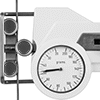Filter by
System of Measurement
Maximum Pressure, psi
Connection Location
For Use With
Measurement Unit
Dial Type
Thread Type
Pressure Numeric Increments
Graduations
Case Material
Connection Material
Maximum Continuous Pressure
Accuracy Scale
DFARS Specialty Metals
About Pressure Gauges
More





























































